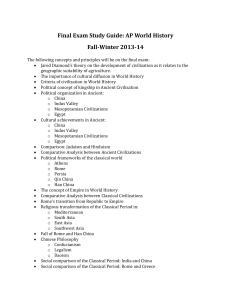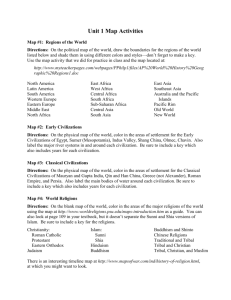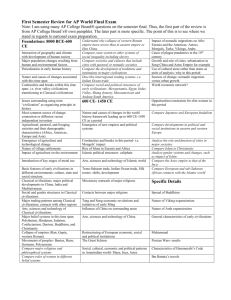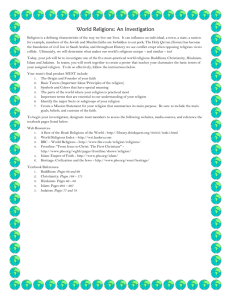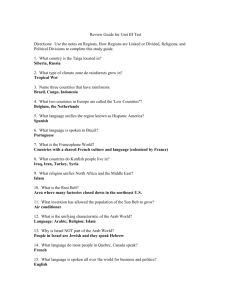POST CLASSICAL PERIOD – 600-1450
advertisement
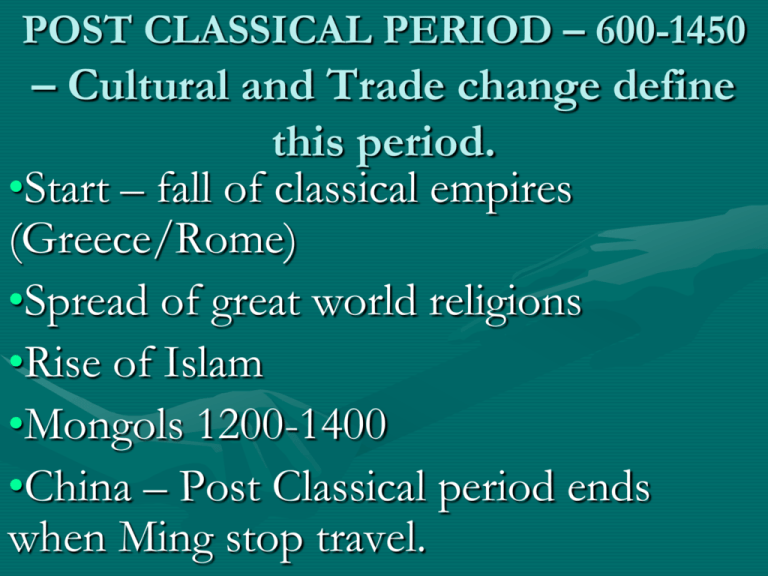
POST CLASSICAL PERIOD – 600-1450 – Cultural and Trade change define this period. •Start – fall of classical empires (Greece/Rome) •Spread of great world religions •Rise of Islam •Mongols 1200-1400 •China – Post Classical period ends when Ming stop travel. PC THEMES 1. ISLAM – rise of Arab Islam becomes the first world class civilization / superpower in world history (before this the best was probably India). PC THEMES 2. Spread of great world religions – Buddhism, Christianity, Islam (most important in the numbers affected). • All 3 religions spread across cultural / political boundaries (missionaries,etc.) – Large numbers convert – syncretic conversion – accept new beliefs but keep some of their own. Religious map of Eurasia set to what it is today. Why convert to new religions? 1. Decline of classical empires – more chaos, death rates increase. ie. China – Buddhism created a decline in secular thought. 2. Fervency of missionaries 3. Governments used Christianity for power – ie. Vladomir in Russia becoming Christian. PC THEMES 3. Civilization spreads to other areas and the number of definable civilizations increases. • Why? Disunity of Mediterranean world. 7 Civilizations by 1450 1.Expanded East Asia 2.S. and S.E. Asia 3.W. Asia (Middle East and N. Africa) 4.Sub Saharan Africa 5. Eastern Europe 6. Western Europe 7.Americas PC THEMES THEME 4. Development of systematic interactions between civilizations – trade contacts. •1000 – dependable trade routes – regular product exchange. •N to S and W to E routes – exchange of technologies and ideas – cultural diffusion. Ie. Arabic numerals from India THEME 4 continued •Travel increases during this period – Ibn Battuta and Marco Polo. •Americas: way behind / random during this period –No disease contact –No technological contact –No animal exchange –Did not use bronze or iron Theme 5 – Women – good and bad Good: spread of world religions – Christianity/ Islam / Buddhism– men and women share spiritual equality (ie. Mohammad). - Equality was not a belief in Classical society – framed within a Patriarchal society. Theme 5 – Women – good and bad Bad: Politically and economically – major deterioration in the life of women. •Veiling – originally from Mesopotamia •Sati – •Footbinding (women as ornamental) •Gaps between men and women economically (men dominated craftworks What themes are NOT present during this time period None of the above themes are political – hard to do that during this period – religion is in control and politics not as important. - not many technological developments. - population growth only in some regions Religions of the Post Classical that were not global •Hinduism – 4th major religion – did not travel well outside of India because it needed the Caste System. Guptas favored Hinduism within India making it strong. •Daoism and Shintoism (Japan) – no missionary qualities. Change and continuity – What changes in the Post Classical in relation to the Foundations / Classical Period? 1. Islam and trade patterns – gains control of Mediterranean trade (most change), some change in India, least change in China. Change in China •Some Islam •Trade routes increase (Song/Ming) •Buddhism •More urban society. 3 types of civilization during the Post Classical period. 1. Most developed – Middle East, North Africa, India, Byzantine Empire. • • • • Classical past to build on Most trade Centralized politically “the developed world at this point in time.” 3 types of civilization during the Post Classical period. 2. Less developed – Japan, Russia, W. Europe, E. Europe, Sub-Saharan Africa, S & E Asia (India and China). • Some world trade – less processed goods. • More decentralized politically – not as large bureaucracies. • Active, self-concious imitators of developed civilizations. (copy religion, alphabets, art – social and cultural things. Less developed, continued •Copy technology, political structure (this one fails – they don’t do a good job of it). •What Western Europe copies from Islam: Gothic arch was Islamic arch, law, commercial law, science and math, role of reason (Averroes). Least developed •Americas – not part of the global scene. – not in contact with world or world religions. – - didn’t matter until contact occurred. – they had their own achievements buth they weren’t as good as the first and second tier countries.


